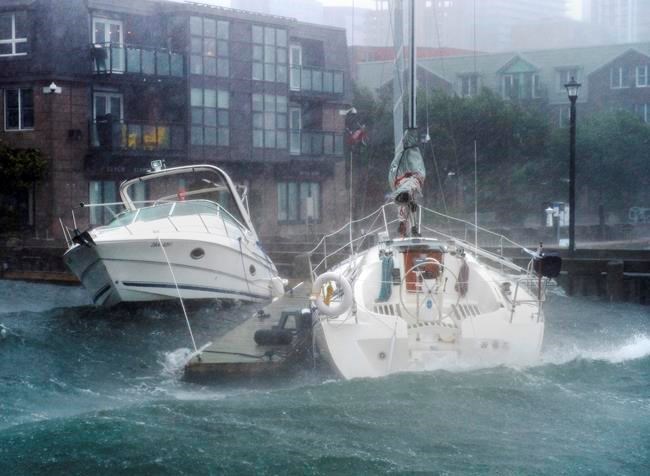As hurricane Dorian barrelled toward the Maritimes on Saturday, its outer bands lashed southern New Brunswick and mainland Nova Scotia with heavy rain and strong winds, causing widespread power outages.
The Canadian Hurricane Centre in Halifax said Dorian was expected to make landfall near Halifax later in the evening, unleashing a heavier barrage of torrential rain, pounding surf and howling gusts reaching up to 150 kilometres per hour.
"The storm is approaching ... (and) it's still a strong storm," said Bob Robichaud, the centre's warning preparedness meteorologist.
Nova Scotia Power Inc. reported more than 250,000 customers were in the dark, including 140,000 in the Halifax area where the wind was gusting at over 100 kilometres per hour by late afternoon.
In New Brunswick, more than 80,000 households and businesses were without power earlier in the afternoon, all of them in the southern reaches of the province.
As Dorian closed in on the Maritimes, it strengthened to Category 2 status with sustained winds reaching 160 km/h, with gusts up to 195 km/h.
However, Robichaud said the storm was expected to weaken by the time it arrived in Nova Scotia as a Category 1 hurricane with sustained winds between 90 km/h and 120 km/h.
"That means numerous broken trees, uprooted trees, heavy rain and the potential for flash flooding," he said.
Prime Minister Justin Trudeau posted on Twitter that the federal government is ready to help Atlantic Canada. Public Safety Minister Ralph Goodale tweeted that the Canadian Armed Forces would be deployed to Nova Scotia to assist with recovery efforts.
In Halifax, officials said they were particularly concerned by reports that many residents and businesses had failed to secure loose objects ahead of the storm.
Erica Fleck, Halifax's assistant chief of community risk reduction, said flower pots, patio furniture, children's toys, ladders and loose construction material can become deadly projectiles when propelled by hurricane-force winds.
Fleck also said the city was encouraging downtown businesses to close early, suggesting residents should heed storm surge warnings and stay away from the waterfront.
"We do not want the citizens of Halifax roaming downtown as the water is coming in," she said.
Meanwhile, emergency officials in the Halifax region have called for a voluntary evacuation of homes and businesses along the municipality's Atlantic shoreline.
With the forecast calling for a significant storm surge and wind-driven waves reaching 15 metres, low-lying coastal communities were facing potential flooding.
Regional officials said the high-risk zones include the Sambro area, Peggys Cove and along the province's Eastern Shore, which extends east of Halifax.
"For the people that live out that way, we urge you ... to move yourself to someplace safe," Fleck said.
The Canadian Red Cross opened three evacuation shelters in the Halifax region. Fleck said more shelters were expected to open Sunday.
Robichaud said western Nova Scotia and southern New Brunswick would likely get between 50 an 100 millimetres of rain, with some areas getting up to 150 millimetres — more rainfall than usually falls in a month.
Greg MacCallum, director of New Brunswick's Emergency Measures Organization, warned against localized and flash flooding, especially in the province's southeast.
Dorian will eventually move into the Gulf of St. Lawrence, where it's set to transform into a strong post-tropical storm.
Iles-de-la-Madeleine was expected to see Dorian pass just to the south by late Saturday, bringing winds of up to 120 km/h coupled with intense rainfall.
Jonathan Lapierre, the mayor of the island municipality, said the community a secured satellite phone system to ensure phone lines would remain operational.
Outside of the Halifax area, fishermen and recreational sailors along the Atlantic coast pulled their boats out of the water or tied them with extra lines.
"Hopefully, we won't have too many tidal surges," said Evan d'Entremont, the 60-year-old owner of Evans Fresh Seafoods in West Pubnico, on Nova Scotia's southwestern coast.
"That's the killer down here."
Farther inland, Nova Scotia apple growers were worried the gusting winds would ruin their crop, still ripening on heavily laden trees. Many farmers brought in extra help earlier in the week to pick as many apples as they could.
With warnings circulating about extended power outages, flooding and damaging winds, many Halifax residents spent Friday stocking up on food, water and gasoline. Long lineups were reported at Halifax-area gas stations and grocery stores.
"I feel that we are completely prepared — as much as we can be — for this storm," Fleck said. "We have taken our lessons learned from hurricane Juan."
Hurricane Juan was a Category 2 storm that hit Halifax early on Sept. 29, 2003. It was also blamed for causing eight deaths, six of them in Nova Scotia.
Juan roared through the middle of the province and over P.E.I., its sustained winds clocked at 157 km/h. As Juan's peak gusts hit 185 km/h to the east of the storm's centre, it uprooted millions of trees and caused more than $200 million in property damage.
– Michael MacDonald, The Canadian Press


